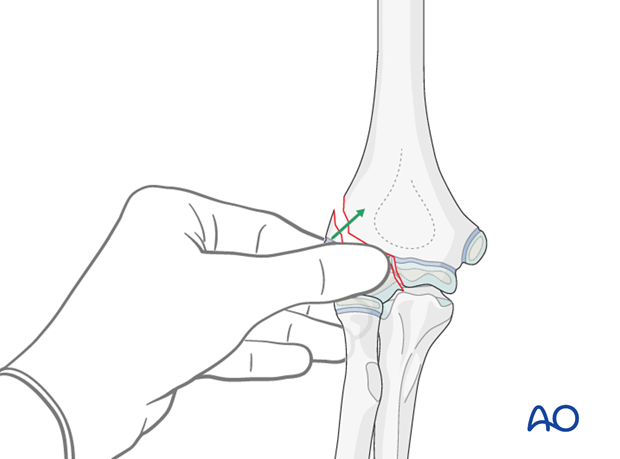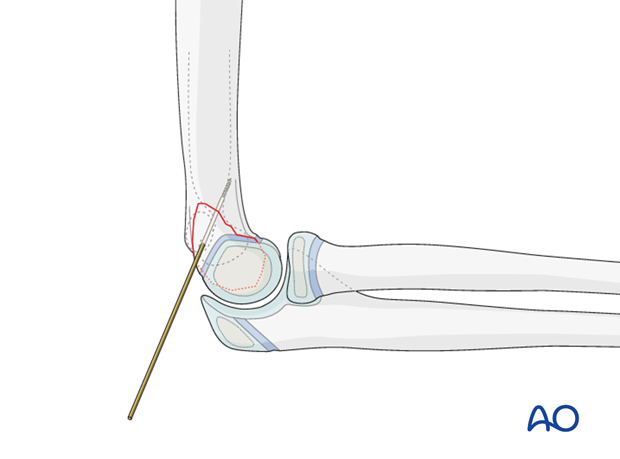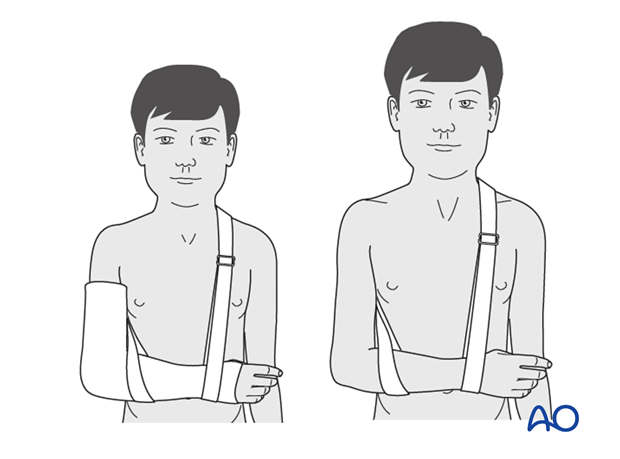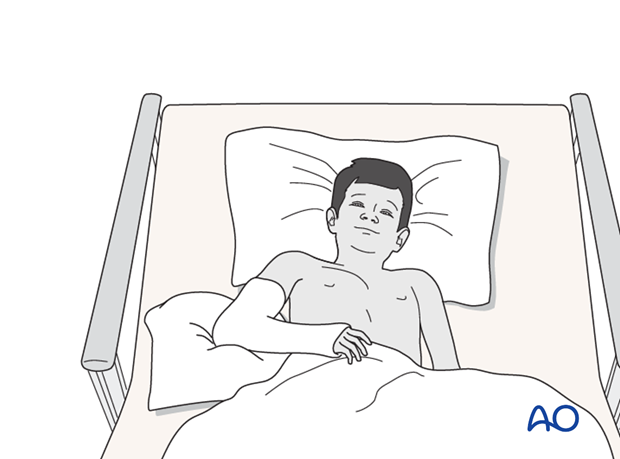Open reduction; screw fixation
1. Goals
The main goals of treatment of these fractures are:
- Uncomplicated healing
- No secondary displacement
- Avoiding overgrowth due to unstable fixation
- Avoiding secondary complications, such as nonunion, leading to additional problems (eg, ulnar nerve irritation)
2. Introduction
Suitable fracture types
13-E/4.1L and 13-E/4.1M with displacement of more than 2 mm in the metaphyseal area, fully displaced, or with elbow instability.
Note: Salter-Harris IV fractures of the medial column are so rare that they will not be considered further in detail. Care must be taken not to damage the ulnar nerve in case of open stabilization of a displaced and unstable fracture of the medial column.

General considerations
The choice of an open reduction and screw fixation is influenced by the following factors:
- Age of the child
- Size of the posterior metaphyseal fragment
- Degree of displacement
- Instability of the elbow joint
Screw fixation is indicated in older children (mostly of school age), with a sizeable metaphyseal fragment, irrespective of the degree of displacement.
3. Preparation
Instruments and implants
Use 3.0 or 3.5 mm cannulated lag screws (ideally self-drilling, self-tapping titanium screws).
The following equipment is needed:
- Cannulated screw set
- Drill
- Cannulated screws (length 25-40 mm)
- 1.25 mm threaded guide wire
- Image intensifier (optional)
- Standard orthopedic instrument set

Anesthesia and positioning
General anesthesia is recommended and a sterile tourniquet should be available. Muscle relaxation is not necessary.
The patient is placed supine with the arm draped up to the shoulder.

4. Approach
As the screw is inserted through the posterior metaphyseal wedge, a posterolateral approach is recommended.

5. Reduction
Reduction options
There are three possibilities to manipulate and reduce the fragments.
Option 1: Direct digital manipulation.

Option 2: Manipulation using a temporary K-wire in the fragment as a joystick.

Option 3: Holding and manipulating the fragment with a small towel clamp or pointed reduction forceps.

A blunt Hohmann lever retractor is inserted gently into the anterior joint, and around the medial articular border.

The medial cartilage fracture line is visualized on the joint surface.
The fragment is manipulated by one of the three options listed above.

The fragment is then reduced so that both cartilage fracture lines (on the fragment and of the trochlea) are perfectly aligned.

6. Fixation
Guide wire insertion for cannulated screw
The fragment is held temporarily in place with the help of a pointed reduction forceps positioned to avoid conflict with the guide wire.

A 1.25 mm threaded guide wire is used for the cannulated screw.
The guide wire is inserted by hand until it has good bony purchase in the metaphyseal fragment.

The position and direction are checked in AP and lateral views using image intensification.

Once position and direction are correct, the guide wire is advanced as far as the anterior cortex in a lateral view.

Screw insertion
The appropriate screw length and size can be determined in two different ways:
- By using a measuring device
- By positioning a second K-wire, of the same length, with its tip on the bone at the entry point and measuring the difference between the protruding lengths of the two wires

The screw is passed by hand over the guide wire, the screw driver is placed over the guide wire, and the screw is fully inserted.

The screw position and fragment compression are verified using image intensification.

7. Optional: additional K-wire or screw insertion
Some surgeons prefer to insert, in addition, a K-wire (but it can also be a second screw) to gain more stability of the fragment, especially to prevent rotation in the epiphyseal area.
Situations when a second implant might be selected are:
- Small additional fragments in the metaphyseal zone
- Very large metaphyseal fragment
- Older and bigger children
- Surgeon's personal preference
- Mobility of fracture line at the joint surface
K-wire insertion
The supplementary 2.0 mm K-wire should be inserted parallel to the joint surface, not parallel to the screw.

As the screw is always buried subcutaneously, the K-wire should be cut and bent under the skin. Both implants can be removed at the same time.

Additional screw insertion
A guide wire is inserted parallel to the joint into the medial side of the trochlea.

The length of the screw is determined as previously described.

The screw is passed over the guide wire, inserted and gently tightened.

8. Aftercare
Note: Screw fixation gives absolute stability and additional plaster cast for immobilization to prevent secondary displacement is not mandatory.
A posterior plaster splint can be applied for 1-2 weeks for pain management, and in younger children to prevent use of the arm. In older children an arm sling is sufficient.

If the child remains for some hours/days in bed, the elbow should be elevated on pillows to reduce swelling and pain.
See also the additional material on postoperative infection and compartment syndrome.

The postoperative protocol is as follows:
- Discharge from hospital according to local practice (1-3 days)
- First clinical and radiological follow up, depending on the age of the child, 4-5 weeks postoperatively out of the cast
- In most cases, at this first x-ray control, the fracture is consolidated and stable so that cast is no longer required
- During the first clinical follow-up, parents/carers should be informed about the timing of implant removal
- Physiotherapy is normally not indicated
Screw removal
The screw can be removed after 2-3 months. Screw removal can be performed as a day case under light general anesthesia.













